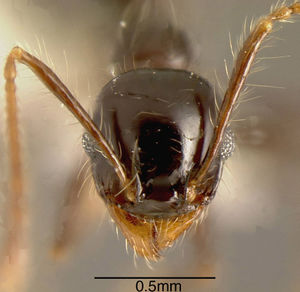Pheidole sensitiva
| Pheidole sensitiva | |
|---|---|

| |
| Scientific classification | |
| Kingdom: | Animalia |
| Phylum: | Arthropoda |
| Class: | Insecta |
| Order: | Hymenoptera |
| Family: | Formicidae |
| Subfamily: | Myrmicinae |
| Tribe: | Attini |
| Genus: | Pheidole |
| Species: | P. sensitiva |
| Binomial name | |
| Pheidole sensitiva Borgmeier, 1959 | |
In Costa Rica, Longino (1997) found the species in litter and recruiting to baits on the floor of rainforests. (Wilson 2003)
Identification
See the description in the nomenclature section.
Keys including this Species
Distribution
Known from the type series from Rio de Janeiro, a series from near San Juan de Arama, Meta, Colombia, and, according to Longino (1997), the Atlantic and Pacific slopes of Costa Rica to 700 m. (Wilson 2003)
Latitudinal Distribution Pattern
Latitudinal Range: 13.7695434° to -12°.
| North Temperate |
North Subtropical |
Tropical | South Subtropical |
South Temperate |
- Source: AntMaps
Distribution based on Regional Taxon Lists
Neotropical Region: Brazil (type locality), Colombia, Costa Rica, French Guiana, Honduras, Nicaragua, Panama, Peru.
Distribution based on AntMaps
Distribution based on AntWeb specimens
Check data from AntWeb
Countries Occupied
| Number of countries occupied by this species based on AntWiki Regional Taxon Lists. In general, fewer countries occupied indicates a narrower range, while more countries indicates a more widespread species. |

|
Estimated Abundance
| Relative abundance based on number of AntMaps records per species (this species within the purple bar). Fewer records (to the left) indicates a less abundant/encountered species while more records (to the right) indicates more abundant/encountered species. |

|
Biology
Castes
Worker
Minor
Images from AntWeb
  
| |
| Worker. Specimen code casent0635525. Photographer J. Longino, uploaded by University of Utah. | Owned by INBio. |
Nomenclature
The following information is derived from Barry Bolton's Online Catalogue of the Ants of the World.
- sensitiva. Pheidole sensitiva Borgmeier, 1959a: 316, figs. 3-9 (s.w.) BRAZIL. See also: Wilson, 2003: 231.
Unless otherwise noted the text for the remainder of this section is reported from the publication that includes the original description.
Description
From Wilson (2003): A small, light reddish brown member of the diligens group with moderately abundant to dense, very long, erect to semierect, often strongly curved hairs.
Major: sculpturing of head consists entirely of carinulae, which are limited to the anterior third of the head capsule and absent from the frontal lobes; promesonotal profile 3-lobed; pronotal humerus rounded in dorsal-oblique view; pilosity of gaster shorter and much denser than on the rest of the body.
Minor: humerus rounded and pronotum smooth and shiny.
Similar to Pheidole longiseta, Pheidole pubiventris and ''Pheidole variegata (= Pheidole pubiventris), differing in many details of body form and sculpturing, as shown.
See also Pheidole blumenauensis, Pheidole rochai, Pheidole seeldrayersi and Pheidole vafra.
MEASUREMENTS (mm) Holotype major: HW 0.94, HL 0.94, SL 0.64, EL 0.16, PW 0.48. Paratype minor: HW 0.58, HL 0.64, SL 0.76, EL 0.14, PW 0.38.
COLOR Major: light reddish brown; gaster a shade darker; appendages yellowish brown. Minor: light brown, gaster a shade darker and appendages a shade lighter than head and mesosoma.
Figure. Upper: holotype, major (tibia shown next to full-face view of head). Lower: paratype, minor. Scale bars = 1 mm.
Type Material
BRAZIL: Jacarepaguá (Taquera), Rio de Janeiro. Museu de Zoologia da Universidade de Sao Paulo - as reported in Wilson (2003)
Etymology
L sensitiva, possibly referring to the sensory function of the long body hairs. (Wilson 2003)
References
- Wilson, E. O. 2003. Pheidole in the New World: A dominant, hyperdiverse ant genus. Harvard University Press, Cambridge, MA. (page 231, fig. major, minor described)
- Borgmeier, T. 1959a. Myrmecologische Studien. II. An. Acad. Bras. Cienc. 31: 309-319. (page 316, figs. 3-9 soldier, worker described)
- Franco, W., Ladino, N., Delabie, J.H.C., Dejean, A., Orivel, J., Fichaux, M., Groc, S., Leponce, M., Feitosa, R.M. 2019. First checklist of the ants (Hymenoptera: Formicidae) of French Guiana. Zootaxa 4674, 509–543 (doi:10.11646/zootaxa.4674.5.2).
- Glaser, S.M., Feitosa, R.M., Koch, A., Goß, N., do Nascimento, F.S., Grüter, C. 2021. Tandem communication improves ant foraging success in a highly competitive tropical habitat. Insectes Sociaux. (doi:10.1007/s00040-021-00810-y).
References based on Global Ant Biodiversity Informatics
- Fernández, F. and S. Sendoya. 2004. Lista de las hormigas neotropicales. Biota Colombiana Volume 5, Number 1.
- Franco W., N. Ladino, J. H. C. Delabie, A. Dejean, J. Orivel, M. Fichaux, S. Groc, M. Leponce, and R. M. Feitosa. 2019. First checklist of the ants (Hymenoptera: Formicidae) of French Guiana. Zootaxa 4674(5): 509-543.
- Kaspari M., D. Donoso, J. A. Lucas, T. Zumbusch, and A. D. Kay. 2012. Using nutritional ecology to predict community structure: a field test in Neotropical ants. Ecosphere 3(11): art.93.
- Longino J. T. L., and M. G. Branstetter. 2018. The truncated bell: an enigmatic but pervasive elevational diversity pattern in Middle American ants. Ecography 41: 1-12.
- Longino J. et al. ADMAC project. Accessed on March 24th 2017 at https://sites.google.com/site/admacsite/
- Pires de Prado L., R. M. Feitosa, S. Pinzon Triana, J. A. Munoz Gutierrez, G. X. Rousseau, R. Alves Silva, G. M. Siqueira, C. L. Caldas dos Santos, F. Veras Silva, T. Sanches Ranzani da Silva, A. Casadei-Ferreira, R. Rosa da Silva, and J. Andrade-Silva. 2019. An overview of the ant fauna (Hymenoptera: Formicidae) of the state of Maranhao, Brazil. Pap. Avulsos Zool. 59: e20195938.
- Smith M. A., W. Hallwachs, D. H. Janzen. 2014. Diversity and phylogenetic community structure of ants along a Costa Rican elevational gradient. Ecography 37(8): 720-731.

